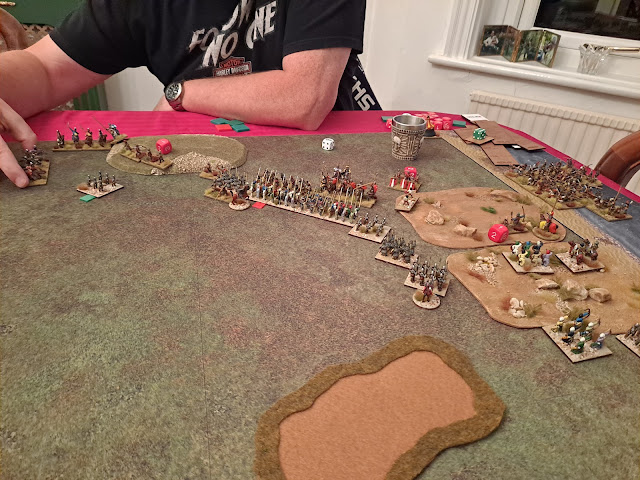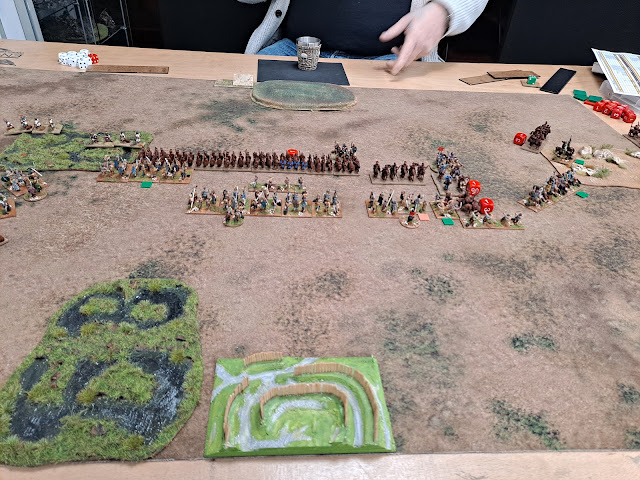Experimentation with Speedpainter 2.0
Background
A couple of years ago I was gifted for Christmas a set of Army Painter Speedpaint. I had a few experiments with it, but candidly I didn't do very much research on how to use it and was not impressed with the results. However, I noticed the release of the new version Speedpainter 2.0 and thought it would be sensible to do some more research on how to use it.
I set about watching lots of, really very good, You Tube videos on the issue, and a huge thanks to the contributors for their guidance. The only challenge from these videos was that they were painting D&D or Warhammer miniatures which, by my estimation, might not be a good reflection of the outcome on historical miniatures. However, at a recent ADLG community meeting at Entoyment I was talking to Harry, as he whopped me in a game, about his experience and the results he had achieved using contrast painting techniques with the 15mm figures he was using. This was sufficient to convince me that I had to give it a go.
I rushed down stairs to the shop at Entoyment in between games, bought some Speedpainter 2.0 paints and some Deus Vault Arabs and vowed to give it a go, and then share my findings.
Source Videos
There are a lot of YouTube videos on how to use Speedpaint and Contrast paints in the Slap Chop technique. I thought it best to share some of them which give a good idea of the technique and the effects.
The Slapchop Painting Technique Speedpainting Miniatures Fast - This is a good starter for the technique with a rather large D&D figure. Interesting in this one that the base is a sand coloured dry brush rather than grey or white.
Is SLAPCHOP the Future of Speed Painting Warhammer?! As a comparison with the previous video this is with figures that are comparable with 28mm historical figures.
Drybrushing SECRETS the masters don't teach! - Become Drybrush PRO in 10 minutes Although this is not about Slap Chop it is directly relevant as it is some really good tips about dry brushing which is important before Slap Chopping your figures. Word-to-the-wise, other videos I have watched mentioned using eye makeup brushes, I purchased a couple from The Range, and they are far superior to the Army painter and other dry brushes you can buy!!
Optimized! My Favorite Speedpaint Technique. Finally this video is really good for showing a variety of techniques and the outcome. Highly recommended as you can see from my examples below.
Progress So far
Okay a few pictures of the progress so far.
First up this is the first try and in this you will be able to see a number of differences on the figures based on the degree of dry brushing etc. Specifically the gentlemen on the left on the back rank has significantly less dry brushing on him. With the one in front of him missing some dry brushing on his waist sash.
Here is the rear view. This gives you a better view of the differences in dry brushing versus a white undercoat. The one on the right is the least dry brushing which shows on his spear. The one in the middle has a little more dry brushing, whilst the one to the left was primed in all white, and here I had to add a little more contrast around the sash and sword belt.
This is a front view of the second attempt. for these all have the same degree of dry brush in grey with edges in white. I used bog-standard grey and white from Hobbycraft as this seemed to be the most cost-effective way of getting the paint. The metals are all Speedpainter metallics with a small level of Vallejo metallics as highlights.
Rear View, and I think the effect is starting to come together nicely, but I will continue to experiment.
This is the third batch, half finished so you can see the depth of grey and then white dry brushing I have applied to a black base coat. Of note the blue coats has been thinned with a 3 parts of Speedpainter thinning medium to 1 part of Speedpainter Raging Sea (Deep Greenish Blue). The deeper colurs can be nicely thinned with the medium to give different effects.
Finally the reverse of the current draft.


















































